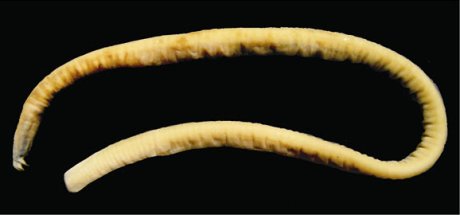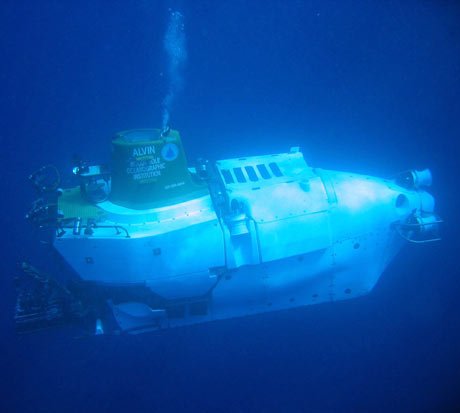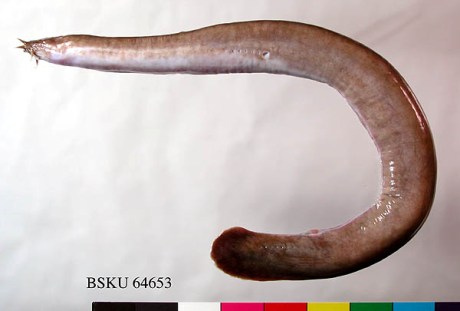New Hagfish Discovered
Posted by: Loren Coleman on February 16th, 2007
A new species, Epatretus strickrotti, is named for the Alvin pilot who captured it.

A dorsal view of the captured hagfish Eptatretus strickrotti, a new species of hagfish captured and named after Alvin pilot Bruce Strickrott. (Illustration by Karen Jacobsen, In Situ Science Illustration. Figure 1 from Moller, P.R., and W. J. Jones. 2007. Biol. Bull. 212: 40-54. Reproduced with permission from MBL, Woods Hole, Mass.)

The lone specimen of Eptatretus strickrotti has been preserved and stored in the California Academy of Sciences in San Francisco. (Figure 1 from Moller, P.R., and W. J. Jones. 2007. Biol. Bull. 212: 40-54. Reproduced with permission from MBL, Woods Hole, Mass.)

Alvin pilot Bruce Strickrott, who captured the first specimen of a new species of hagfish now named after him. (Courtesy of NOAA Ocean Explorations)

Bruce Strickrott has piloted more than 200 dives on the WHOI-operated submersible Alvin. (Photo by Mark Spear, Woods Hole Oceanographic Institution)
It’s not hard to figure out how hagfish got their name, since they aren’t exactly warm and fuzzy. Slithery, skinny, coated in gooey slime, and often found wriggling and eating in the guts of dead whales, most people probably don’t want to be associated with them. When Alvin pilot Bruce Strickrott captured a specimen of the worm-like fish during a dive in the cold, inky Pacific depths in March 2005, he recalled thinking it was “cool … but in a hideous sort of way.”
About a year later, he learned scientists wanted to name it for him. It turns out that the fish he spotted swimming at a depth of 7, 218 feet (2,200 meters) during an oceanographic expedition south of Easter Island was among the first hagfish captured from a hydrothermal vent site. Morphological studies and genetic analyses confirmed what researchers had then suspected: The hagfish was a new species, and one of the deepest-dwelling of its kind.
Suddenly, Strickrott felt not repulsed but nearly paternal about the 18-inch (45-centimeter) fish he withdrew from the depths.
“It’s a feather in my cap,” Strickrott said of the announcement of his namesake hagfish, Eptatretus strickrotti. “It’s recognition from researchers for my contributions to the advancement of science.”
An article announcing the new species, by Peter Møller of the Zoological Museum of the University of Copenhagen and W. Joe Jones of the Monterey Bay Aquarium Research Institute (MBARI), was published in the February 2007 issue of the science journal Biological Bulletin.
What’s in a name?
The naming initiates Strickrott into a unique fraternity of least a half-dozen pilots of the deep-sea submersible Alvin whose surnames are now intertwined with species of jellyfish, worms, nematodes, and slugs. Like explorers who name rivers and mountains for their dedicated guides, grateful biologists occasionally christen newly discovered species for the pilots who have safely and skillfully navigated them around ocean depths.
The 2-inch (5-centimeter) -long ctenophore Bathocyroe fosteri was named for Alvin pilot Dudley Foster, who collected the first specimens in 1978 from the Atlantic Ocean. Paul Tibbetts, the pilot who in 1988 captured a new type of mussel in the Pacific, was acknowledged when biologists named the shelled mollusk Punctabyssia tibbettsi.
“Without Alvin pilots, many oceanographers could not get their jobs done, and we want to recognize the commitment of these dedicated people,” said Jones, a genetics specialist at MBARI who was in Alvin with Strickrott during the hagfish’s capture.
“We saw this little thing swimming like a worm and I told Bruce, ‘There is no way you are going to catch it,’ ” Jones said. Strickrott—who has logged more than 1,600 hours and 200 dives in Alvin since becoming a pilot 10 years ago—accepted the challenge. Within moments, he maneuvered the 23-foot-long submersible behind the wiggling fish and then vacuumed it into a canister mounted on the sub through a 0.2-inch (0.5-centimeter) -wide tube known as the “slurp gun.”
“I was like, ‘Man, this guy has skills and deserves recognition,’ ” Jones said. “The naming was a way to express our gratitude.”

(For more on this hagfish, clickhere to read more of Amy E. Nevala’s article.)
Strickrott, meanwhile, has taken good-natured ribbing about his namesake fish from “individuals who argue that the characteristics of a hagfish seem to match the persona of some Alvin pilots.”
“Slimy bottom dweller,” he deadpanned. “How fitting.”
About Loren Coleman
Loren Coleman is one of the world’s leading cryptozoologists, some say “the” leading living cryptozoologist. Certainly, he is acknowledged as the current living American researcher and writer who has most popularized cryptozoology in the late 20th and early 21st centuries.
Starting his fieldwork and investigations in 1960, after traveling and trekking extensively in pursuit of cryptozoological mysteries, Coleman began writing to share his experiences in 1969. An honorary member of Ivan T. Sanderson’s Society for the Investigation of the Unexplained in the 1970s, Coleman has been bestowed with similar honorary memberships of the North Idaho College Cryptozoology Club in 1983, and in subsequent years, that of the British Columbia Scientific Cryptozoology Club, CryptoSafari International, and other international organizations. He was also a Life Member and Benefactor of the International Society of Cryptozoology (now-defunct).
Loren Coleman’s daily blog, as a member of the Cryptomundo Team, served as an ongoing avenue of communication for the ever-growing body of cryptozoo news from 2005 through 2013. He returned as an infrequent contributor beginning Halloween week of 2015.
Coleman is the founder in 2003, and current director of the International Cryptozoology Museum in Portland, Maine.










Hagfish can also extrude several pounds of mucous from their bodies when threatened, making them harder to capture or swallow. Yum.
That’s not a hagfish, that’s a goa’uld larva!
😉
Slurp gun? Marine Biologists get all the cool toys.
Well, a new species is a new species, but … YUCK.
Eptatretus strickrotti
The life cycles of these hagfish and related lamprey species potentially casts an interesting light onto the subject of cryptozoology. They are well adapted for their lifestyle of scavenging. Interesting too; lampreys go through a long larval stage…sometime many years in length. As a scavenger their strategy seems to be “wait” while staying buried in the cold mud. They are well adapted for this and are recognized for their ability to go for long periods of time without eating. It’s been speculated that some species are particularly well adapted for living in submarine alluvial fans, burrowing into the mud, waiting for storms powerful enough to bring fresh dead stuff their way. People who study ecology and climate recognize that animals with long larval stages are likely tuned into rhythms and cycles in nature. Locust, Mormon Crickets, and cicadas are well known examples of insects who exhibit this. As humans we might not be aware that there’s a 17 year cycle that the cicadas observe, but you can’t argue that it is there, considering the success of these insects.
We’ve become accustomed to hearing about “100 year storms” and “50 year storms”. An ecologist whom I’d met was commenting on how some populations of animals are tuned into these long cycles, and additionally commenting on how difficult it would be to observe them for us since they are taking places in areas away from the light of the surface.
Cave Crickets have been found to live many many years and it’s been suggested they could live for 200 or more, patiently waiting, with its metabolism in stasis, the stable cold temperatures being ideal for this. Likewise, the alluvial fans of great rivers are very deep and very cold, but periodically, a great storm or a submarine landslide send a gigantic storm of turbidity out across the cold dark delta and things that have been patiently waiting for a long long time recieve signals that it is time.
Maybe HP Lovecraft was on to something.
That’s great a new Hagfish, I was worried that we didn’t have enough mucus in the world!
Isnt this exciting? Hagfish are amoungst the most delightfully yucky creatures in the world, their cleaning up ability, and sliming. it is said that a hagfish put into a bucket of water can turn it to goo in seconds.
having no bones, they can tie themselves in knots, indeed this is one way they squirm into things.
they are a particular delicacy in Korea, where they are called `slime eels` they are so much indemand, there is an import industry in that country.